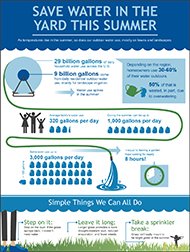Watering Tips

Tired of dragging out the hose every day or letting your sprinkler soak the sidewalk? Along with our Sprinkler Spruce-Up page, the following tips can help you water less and water smarter.
On this page:
Timing Is Everything
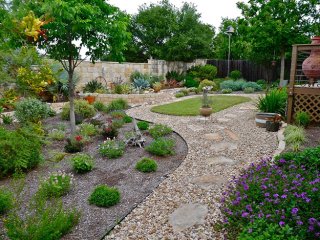
No matter what kind of yard or landscape you have, it's important to know exactly how much water your plants need before you turn on the sprinkler. Smart watering practices reduce runoff and may decrease the need for pesticides and fertilizers.
Contact your local water utility to find out exactly how much and when you should be watering and keep the following questions in mind when you water so that you can maintain a beautiful and healthy yard without wasting water or money.
When?
Avoid watering in the middle of the day when the hot sun will evaporate much of the water before it can get to thirsty plants.
How often?
Your landscape will typically require one inch of water a week, including rainfall, and that can vary depending on where you live, recent weather, and the plants in your landscape. Your area's Cooperative Extension Service or local water utility can provide advice on how often to irrigate shrubs, trees, and other perennials.
How long?
Give this a try! Place a few empty tuna cans around your lawn while you're watering and measure how long it takes your sprinkler to fill them with a half inch of water. Then, try watering that amount of time twice a week, gauge how your landscape responds, and adjust based on weather conditions.
If water begins to pool, turn off your sprinkler to prevent overwatering, weed growth, disease, fungus, and stormwater runoff that pollutes local waterways with fertilizers and pesticides. Watering plants or grass too frequently can drown plants or result in shallow roots. You can simplify your irrigation schedule by replacing your standard clock timer controller with a WaterSense labeled irrigation controller.
Water can easily pool on some landscapes with clay-rich soils or slopes if water is applied too quickly. These landscapes can benefit from dividing irrigation runtimes into intervals with short breaks in between to allow water to soak into the soil. Keep water in your landscape and reduce overwatering by implementing Cycle-and-Soak (PDF).
What else?
When the rain does come, saving water from storms or diverting rainwater back to the landscape is a great way to supplement your efficiency measures. Rain barrels or cisterns can be used to harvest rain water for irrigation and other outdoor water uses. Some states might have laws that prohibit collection of rainwater, so be sure to check with your state's water resource agency before implementing a rainwater collection system. Rooftop downspouts can also be diverted towards rain gardens that easily soak up the rain rather than sending it to stormwater drains.
- For more on rainwater collection, visit EPA's Green Infrastructure Web page: Rain Harvesting.
- Learn how to keep rain where it falls, visit EPA's Soak up the Rain effort
- Alternative Water Sources Maps – DOE provides information on rainwater harvesting regulations by state.
Smarter Technology Can Help
Using water-efficient technologies can make a big difference in keeping your residential or light commercial irrigation system running efficiently without a lot of effort on your part.
Water at the right time and give plants only what they need.
Clock-based irrigation controllers set a schedule that turns your irrigation system on and off. WaterSense labeled irrigation controllers provide a smart way to reduce irrigation that occurs when plants don’t need it. There are two types of controllers that can earn the WaterSense label: weather-based irrigation controllers can help reduce water waste by adjusting your irrigation schedule based on local weather and landscape conditions.
Soil moisture-based irrigation controllers, also known as soil moisture sensors, water plants based on their needs by measuring the amount of moisture in the soil and tailoring the irrigation schedule accordingly.
Give plants only the water they need.
Soil moisture-based control technologies water plants based on their needs by measuring the amount of moisture in the soil and tailoring the irrigation schedule accordingly. WaterSense has issued a draft specification to label soil moisture-based control technologies.
Use efficient sprinklers to avoid water waste.
High pressure can cause sprinklers to spray water faster than expected, causing areas of the landscape to flood. WaterSense labeled spray sprinkler bodies, which feature integral pressure regulation, can help decrease the outdoor water waste associated with irrigation systems that receive water under higher pressure.
Install a microirrigation system for gardens, trees, and shrubs.
Microirrigation applies water slowly and directly to the plants’ roots where the water is needed most. WaterSense has two different guides available to help irrigation professionals and homeowners understand the benefits of microirrigation.
Manage Your Irrigation System
- Adjust your irrigation system often.
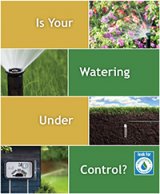
- Set sprinklers to keep the water on the landscape and off the pavement. Lots of water is wasted by poorly designed and neglected sprinkler systems that spray sidewalks, driveways, and the street. Save water by directing sprinklers toward the landscape.
-
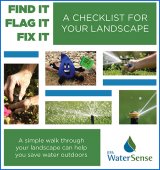
-
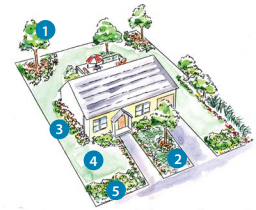
- Check for WaterSense! A certified irrigation professional can design, install, maintain, or audit your system to ensure you're using the proper amount of water to support a healthy landscape. Ask if your irrigation contractor is certified by a WaterSense labeled program.

